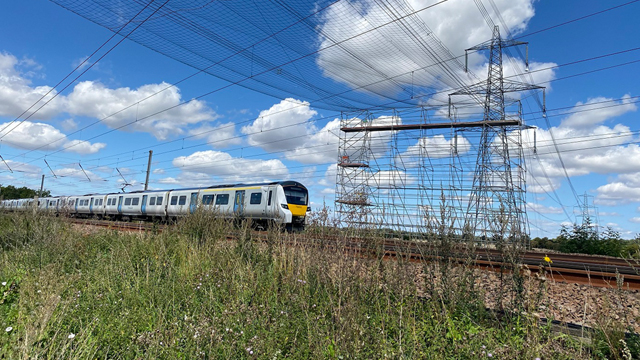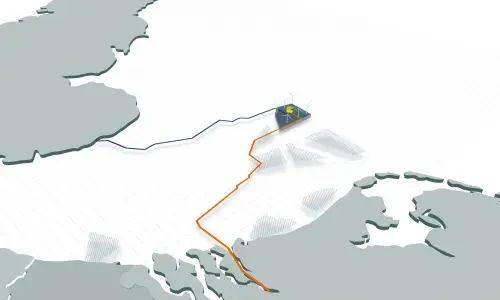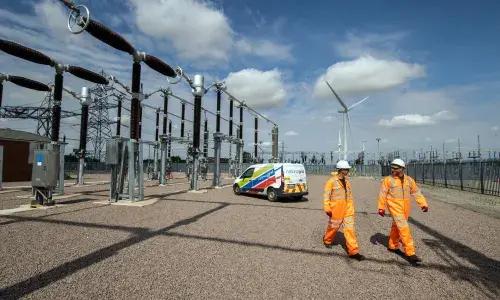
National Grid strengthens transmission network with crucial refurbishment project
- 170km of overhead power line between Lincolnshire and Hertfordshire is being refurbished.
- Engineers have installed a total of 2,919km of new overhead line conductor working at heights of up to 50m, across 78 calendar years of combined working hours.
- Three of four north-south circuits on the electricity transmission network have been refurbished, with completion of the fourth circuit expected in 2024.
- Refurbishment forms part of National Grid’s £1 billion annual investment in maintaining and upgrading its infrastructure to ensure a resilient and reliable network for homes and businesses in England and Wales.
National Grid is delivering a £130 million project to refurbish and strengthen the existing overhead line network, (the high-voltage wires that transport electricity) between Lincoln and Stevenage.
Video showing work being undertaken during Phase One of the overhead line refurbishment project between Lincolnshire and Hertfordshire.
National Grid’s Operations teams and Morrison Energy Services have been working at heights of up to 50m, installing 2,919km of new overhead line conductor to replace the original, which was installed in the 1960s and is now approaching the end of its scheduled working lifespan.
Three of four north-south circuits on electricity transmission network have now been refurbished, allowing them to continue to function reliably, with completion of the fourth circuit expected in 2024.
Work on the transmission line which runs from Cottam Power Station near Lincoln to Wymondley Substation near Stevenage, passing near Newark, Stamford, Peterborough and Hitchin, started in March 2022 and covers two project phases.
The first phase of the works from Lincoln to Peterborough was completed last year and a further 1,479km of overhead line conductor has been installed so far in this year’s second phase, which runs from Stamford to Stevenage.
Each section of work has involved in depth planning around outages - when the system operator can afford to take a particular circuit off the live network.
The final circuit, which runs from Cambridgeshire to Hertfordshire, will be replaced to complete the project in 2024.
The refurbishment of this piece of the national network enables power to continue to feed into regional electricity networks, who distribute it to homes and businesses at lower, more usable voltages. Once complete, the new line will not only strengthen the existing infrastructure from Lincolnshire through to Hertfordshire but will also ensure the network is able to continue to transport increasing volumes of renewable power.
The project forms part of National Grid’s management of the high-voltage network in England and Wales. 900 operational colleagues work 365 days a year to maintain the network, monitoring over 21,000 pylons, over 7,000 kilometres of overhead line (the same distance as London to Miami) and over 700 kilometres of underground cable.
More than £1 billion a year is invested to adapt and upgrade the transmission network, ensuring it is robust against severe weather, including storms and heatwaves and enabling the connection of more renewable power to help reduce emissions.
Edward Maddams, Overhead Line Project Manager for National Grid said: "These are some staggering statistics when reflecting on the amount of hard work that has gone into this job to date, and I would like to recognise the great teamwork, dedication, and skill of all involved in the project.
I would also like to thank the local communities and landowners we continue to work with, for their co-operation in enabling us to make great progress in maintaining the health of our network and ensuring it continues to deliver safe and secure electricity.”
In addition to replacing the overhead lines, specialist teams climbed and surveyed 478 pylons along the 170km route and fitted around 80 tonnes of steel to reinforce the pylons to support the new line system. The project team have already amassed an impressive record across both phases, sharing the following highlights to date:
- Total length of conductor cable installed: 2,919 kilometres.
- Scaffolds erected and dismantled: 215.
- Tonnes of scaffolding: 5,498.
- Conductor drums used to transport the overhead lines to and from site, weighing up to 6 tonnes each: 3,020.
- Temporary road panels: 84,500
- Ecologically sensitive sites managed: 768.
- Rail and road crossings protected: 232.
- Rivers crossed: 2.
- Total hours worked: 78 calendar years of combined working hours.
Ends
Contact for media information only:
Paige Phelps
National Grid
07543312572


